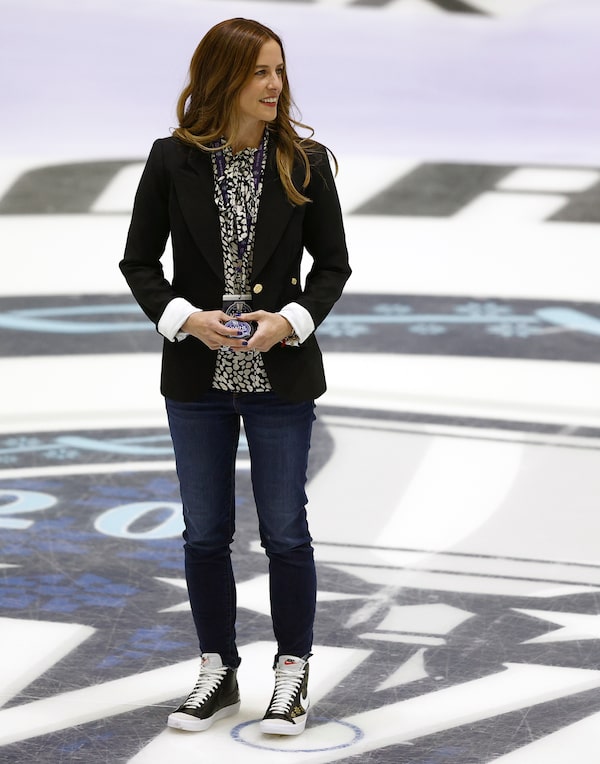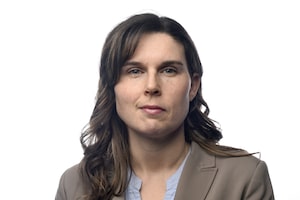
The National Women’s Hockey League changed its name to the Premier Hockey Federation before its seventh season, becoming the first North American women’s sports league to drop the gender designation from its title.Mary Schwalm/The Associated Press
What’s in a name?
When it’s the title of a sports league, is a name merely a group of words that differentiate it from all other leagues? The renaming of one North American hockey league suggests that a name can also speak to how a league wants to be considered, not just who plays in it.
Earlier this month, the National Women’s Hockey League (NWHL) changed its name to the Premier Hockey Federation (PHF) before its seventh season, becoming the first North American women’s sports league to drop the gender designation from its title.
Announcing the new name and new logo, the league, with five teams in the United States and one in Toronto, said the rebranding recognizes its hockey players for their athletic talent, not their gender. It also aims to respect differences in the gender identity of its current and future players and league stakeholders. Not all of its athletes identify as female, so the change also reinforces the league’s inclusion of transgender and nonbinary players.
“We’re building this federation on a platform that the athlete should be judged on their skill, and not by their gender identity,” PHF commissioner Tyler Tumminia said. “We had a lot of athletes that felt really passionate about the idea of no labels, no limits. No one refers to the NHL as the National Men’s Hockey League. Our players were a little bit tired of always hearing ‘woman athlete’ or, ‘she’s female phenomenal’. Our players deserve a name that empowers them as equals in professional sports.”
The conversation about renaming women’s entities has long been ongoing in sports.
Many U.S. universities that once differentiated their women’s teams by sticking words such as “Lady” in front of the school’s team nickname have stopped doing that. Baylor University’s women’s basketball team kept their Lady Bears name long after most had moved away from that tradition, but earlier this month they, too, became simply the Baylor Bears, to match the other teams at their school.
While lifting the W or the word Lady out of a title may seem like a small thing, it means a lot, says Carly Jackson, a Canadian goalie for the Buffalo Beauts who will regularly travel 230 kilometres from London, Ont., to play, while also doing graduate studies at the University of Western Ontario.
“It’s exciting as a player, the idea of being defined by your qualities as an athlete, instead of as being male or female or non-binary,” said Jackson, who was the third-overall draft pick in the 2020 NWHL draft. “You should be defined by your player abilities as a professional, like a hard worker, a great locker room person, a good penalty killer, or goal scorer. It will be exciting as an athlete to be asked questions about things like that.”

League Commissioner Tyler Tumminia said teams landing private ownership for all its clubs has been a positive move away from the league-owned model.Maddie Meyer/Getty Images
While the crux of the NWHL’s rebrand to PHF is the removal of gender from its title, it also comes at a time when the league is entering a new era, of sorts.
“Our league our has really changed in the last 10 months,” said Tumminia, a former baseball executive and partial owner of several minor-league baseball clubs, who took over as commissioner in October.
Despite the pandemic and its 2020-21 season being severely shortened, there was growth in the league. Tumminia points to things such as landing private ownership for all its clubs so it could move away from the league-owned model. The league experienced big-game streaming numbers on Twitch, record sponsorship deals, raised the Isobel Cup on a national broadcast for the first time in Season 6, and doubled the league’s salary cap for Season 7.
But alongside the growth have come some image problems, lingering since the league’s inception in 2015. Player salaries were slashed in 2016, which left some lingering distrust of then-commissioner and founder Dani Rylan. The bubbled 2020-21 playoff tournament in Lake Placid, N.Y., was disrupted by positive COVID tests, and there was a high-profile public spat with Barstool Sports. Also, some fans criticized Toronto Six coach Digit Murphy who had, for a time, been listed as a supporter of the Women’s Sports Policy Working Group, which has been scrutinized for alleged transphobic ideas.
The PHF’s biggest issue still persists: the best women in the world still don’t play in their league. Most national team athletes from Canada and the United States choose instead to play for the Professional Women’s Hockey Players Association (PWHPA), which has teams in Montreal, Toronto, Calgary, Minnesota and New Hampshire, and plays travelling showcases for prize money, some staged in partnership with NHL clubs. Many of those stars criticized the travel, pay and training conditions of the then-NWHL from their past experiences playing there.
“Communication between the PWHPA and PHF has never been better,” Tumminia says of the PWHPA. “We’re talking more now than we have in the last three years. And our goals continue to align. We both want the best opportunity for athletes in the sport.”
The PHF has improved the player experience, from travel, to equipment, off-ice gear, locker rooms, pregame and postgame meals and player-relocation stipends.
“Some of those players have long memories about what they didn’t like in the past – like four, five years ago, and aren’t as willing as we would like to see for them to give our league another try,” said Miles Arnone, who chairs the ownership group for the Isobel Cup champion Boston Pride. “What they’ve publicly said they want, we’re already doing. I challenge anyone to compare the conditions and the opportunities and the support that our players get against what players on the PWHPA tour.”
More sponsorship deals and corporate partners, plus an increased commitment from private ownership has helped double the salary cap to US$300,000 a team for the 2021-22 season – the highest in league history. The roster size remains the same (between 20 and 25), and so does the number of games on the schedule. So the larger cap will mean more money for each athlete, without an increased workload. The players also get shares of league-wide revenue deals and jersey sales.
Arnone says the top players could make upward of US$30,000 a season – still not a full-time livable wage, but a big increase.
Instead of a regular season last winter, the league held a two-week “bubble” playoff tournament at historic Herb Brooks Arena in late January, with NBCSN set to televise the semis and final, the first time women’s pro hockey games would air live on a major American cable network. Before those playoff rounds arrived, two teams had to drop out after outbreaks of COVID-19 and the tournament was halted.
The tournament resumed in Boston in March, the Cup was awarded, and the league still got to make history with NBCSN televising its semis and final, with an all-female broadcast team.
The PHF opens its new season Nov. 6, the first look at the league’s new era and its enhanced focus on inclusivity. All six teams will be in action.
“I was extremely proud to play in the NWHL but when I was asked where I played hockey by strangers it would give me anxiety to state the full league name and essentially out myself,” Harrison Browne, a transgender athlete who retired from the league in 2018 and identifies with he/him pronouns, wrote on Twitter. “This is a very important move for non-binary or trans hockey players.”
Ann Pegoraro, Lang chair in sport management at the University of Guelph, wonders why this rebrand was not immediately accompanied by a fresh policy on transgender athletes, a new website and new handles on social media that include the league’s new name.
Those things all remain the same as they were before the rebrand. The transgender-player policy on the league’s website is dated Oct. 29, 2020, and bases the player’s eligibility on testosterone levels.
“With my gender-equity hat on, I’m all for this dropping of the gender modifier from the league title, that’s great, but they needed to follow it up much better from a marketing perspective,” Pegoraro says. “Plus, they just got some great momentum from last season, reached new audiences on NBC and Twitch, created lots of brand awareness with their old name, and then they changed it.”
The COVID-19 protocols for fan attendance at PHF games are still to be announced. The PWHPA will be in action too, with its first tour stop on Nov. 12 and 13 in Truro, N.S. Both groups will hope to capitalize on the audiences that grow their appetites for women’s hockey during the Beijing Olympics in February.
 Rachel Brady
Rachel Brady